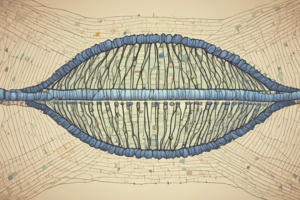Podcast
Questions and Answers
What percentage of DNA do humans share, highlighting the subtle yet significant nature of genetic variation?
What percentage of DNA do humans share, highlighting the subtle yet significant nature of genetic variation?
- 99.5%
- 99.9% (correct)
- 99.0%
- 99.99%
Clinical features of specific genetic diseases are a core part of the course examination criteria.
Clinical features of specific genetic diseases are a core part of the course examination criteria.
False (B)
Which of the following best describes a single nucleotide variant (SNV)?
Which of the following best describes a single nucleotide variant (SNV)?
- Inversion of a segment of a chromosome
- Duplication of an entire gene sequence
- A substitution of a single nucleotide within a DNA sequence (correct)
- A large-scale deletion of a chromosomal region
A genetic variant is considered a common variant if it has an allele frequency of greater than ______ in a population.
A genetic variant is considered a common variant if it has an allele frequency of greater than ______ in a population.
Match the following types of DNA variation with their corresponding descriptions:
Match the following types of DNA variation with their corresponding descriptions:
In cDNA nomenclature, if the 'A' of the ATG initiation codon is designated as nucleotide #1, how are upstream nucleotides numbered?
In cDNA nomenclature, if the 'A' of the ATG initiation codon is designated as nucleotide #1, how are upstream nucleotides numbered?
Terms such as 'SNP', 'polymorphism', and 'mutation' are still the best terms for describing genetic variation in modern genetics and are encouraged.
Terms such as 'SNP', 'polymorphism', and 'mutation' are still the best terms for describing genetic variation in modern genetics and are encouraged.
Which of the following best explains 'anticipation' in the context of genetic disorders?
Which of the following best explains 'anticipation' in the context of genetic disorders?
In protein sequence nomenclature, amino acids are numbered starting with the initiation codon, which is designated as number ______.
In protein sequence nomenclature, amino acids are numbered starting with the initiation codon, which is designated as number ______.
Match the type of SNV effect with the correct description.
Match the type of SNV effect with the correct description.
Which of the following is the most common cause of X-linked Duchenne muscular dystrophy?
Which of the following is the most common cause of X-linked Duchenne muscular dystrophy?
Origins of sequence variants is never due to replication errors.
Origins of sequence variants is never due to replication errors.
What size nucleotide units are found in Microsatellites?
What size nucleotide units are found in Microsatellites?
In intronic sequence nomenclature, the sequence is numbered according to the first or last coding nucleotide in the nearest ______.
In intronic sequence nomenclature, the sequence is numbered according to the first or last coding nucleotide in the nearest ______.
Match the disease with its repetitive expansion.
Match the disease with its repetitive expansion.
Which processes can cause DNA damage?
Which processes can cause DNA damage?
Microsatellites never have a clinical impact.
Microsatellites never have a clinical impact.
Deamination accounts for about what percentage of substitutions?
Deamination accounts for about what percentage of substitutions?
Diseases can show anticipation through only one parent, such as Myotonic Dystrophy/Fragile X ( ______ ) / Huntington (paternal).
Diseases can show anticipation through only one parent, such as Myotonic Dystrophy/Fragile X ( ______ ) / Huntington (paternal).
Match the following uses for microsatellites with their descriptions:
Match the following uses for microsatellites with their descriptions:
State the minimum allele frequency percentage that determines if a genetic variant is common.
State the minimum allele frequency percentage that determines if a genetic variant is common.
Define genetic 'anticipation' in neurological disorders associated with dynamic repeats.
Define genetic 'anticipation' in neurological disorders associated with dynamic repeats.
If a DNA sequence change results in a codon that still codes for the same amino acid, it is described as what?
If a DNA sequence change results in a codon that still codes for the same amino acid, it is described as what?
Dynamic repeats adhere to typical Mendelian inheritance patterns.
Dynamic repeats adhere to typical Mendelian inheritance patterns.
What is the key characteristic of microsatellites that makes them easily detectable using PCR?
What is the key characteristic of microsatellites that makes them easily detectable using PCR?
What is the minimum number of base pairs that must change for SNV to result in shift of the codon reading frame (frameshift)?
What is the minimum number of base pairs that must change for SNV to result in shift of the codon reading frame (frameshift)?
List the three uses for Microsatellites.
List the three uses for Microsatellites.
According to the information about anticipation, which parent is typically associated with Huntington’s disease?
According to the information about anticipation, which parent is typically associated with Huntington’s disease?
Charcot-Marie-Tooth disease is a neuropathy mediated with direct repeats.
Charcot-Marie-Tooth disease is a neuropathy mediated with direct repeats.
Which of the following is most susceptible to DNA damage?
Which of the following is most susceptible to DNA damage?
Larger the Dynamic repeat's expansion, the more stable it becomes for the next generation.
Larger the Dynamic repeat's expansion, the more stable it becomes for the next generation.
Provide two potential roles for ALU elements in CNVs.
Provide two potential roles for ALU elements in CNVs.
Describe three effects that may result from SNVs on gene products.
Describe three effects that may result from SNVs on gene products.
Non-Allelic Homologous Recombination (NAHR) favors what?
Non-Allelic Homologous Recombination (NAHR) favors what?
Factor VIII inversions are mediated by direct repeats.
Factor VIII inversions are mediated by direct repeats.
What level of change can cause dynamic repeats?
What level of change can cause dynamic repeats?
Provide four characteristics of anticipation
Provide four characteristics of anticipation
Synonymous (silent) sequence change alters an amino acid coded.
Synonymous (silent) sequence change alters an amino acid coded.
Replication fork movement can cause discontinuous synthesis, also known as ______ fragment.
Replication fork movement can cause discontinuous synthesis, also known as ______ fragment.
Which of the following events best describes the nonsense single nucleotide variant?
Which of the following events best describes the nonsense single nucleotide variant?
A common allele frequency of a variant is greater than 10% in general.
A common allele frequency of a variant is greater than 10% in general.
Flashcards
Human DNA Similarity
Human DNA Similarity
Individuals share 99.9% of their DNA, but differ at 3,300,000 bases.
Genetic Variation Objectives
Genetic Variation Objectives
These delineate the different types of genetic variation and their mechanisms of origin.
Nucleotide Change Objectives
Nucleotide Change Objectives
These describe the effects of nucleotide changes on protein sequences.
Genetic Variation Levels
Genetic Variation Levels
Signup and view all the flashcards
Whole Chromosome Variation
Whole Chromosome Variation
Signup and view all the flashcards
Variant Effect Factors
Variant Effect Factors
Signup and view all the flashcards
Genetic Variant Terminology
Genetic Variant Terminology
Signup and view all the flashcards
Common Variant
Common Variant
Signup and view all the flashcards
Rare Variant
Rare Variant
Signup and view all the flashcards
Small DNA Variation
Small DNA Variation
Signup and view all the flashcards
Copy Number Variation
Copy Number Variation
Signup and view all the flashcards
Single Nucleotide Variant
Single Nucleotide Variant
Signup and view all the flashcards
Synonymous Variant
Synonymous Variant
Signup and view all the flashcards
Non-Synonymous
Non-Synonymous
Signup and view all the flashcards
Nonsense Mutation
Nonsense Mutation
Signup and view all the flashcards
Start Codon Variant
Start Codon Variant
Signup and view all the flashcards
Read-through Variant
Read-through Variant
Signup and view all the flashcards
Splicing Variants
Splicing Variants
Signup and view all the flashcards
Small Duplications/Deletions
Small Duplications/Deletions
Signup and view all the flashcards
Somatic Changes
Somatic Changes
Signup and view all the flashcards
Germline variants
Germline variants
Signup and view all the flashcards
Replication Errors
Replication Errors
Signup and view all the flashcards
DNA Damage
DNA Damage
Signup and view all the flashcards
Dynamic Repeats
Dynamic Repeats
Signup and view all the flashcards
Microsatellites
Microsatellites
Signup and view all the flashcards
Microsatellite Uses
Microsatellite Uses
Signup and view all the flashcards
Twin Studies
Twin Studies
Signup and view all the flashcards
Large Deletion/Duplication
Large Deletion/Duplication
Signup and view all the flashcards
CMT1a
CMT1a
Signup and view all the flashcards
Factor VIII Inversions
Factor VIII Inversions
Signup and view all the flashcards
DMD Exon-level duplications.
DMD Exon-level duplications.
Signup and view all the flashcards
Study Notes
Genome and Genetic Variation
- Clinical features of specific genetic diseases are for educational enrichment and will not be examined.
- Humans share 99.9% of their DNA.
- Individuals differ by approximately 3,300,000 bases.
- The subsequent text will cover Molecular Genetics.
Learning Objectives
- Describe different types of genetic variation and their mechanisms.
- Describe the effect of nucleotide changes on protein sequence.
- List unique features of dynamic repeats, including the phenomenon of anticipation.
Genetic Variation
- Genetic variation occurs at different levels:
- Chromosome level (microscopic)
- Sub-chromosomal level (copy number variation)
- Single nucleotide level
- Approximate variation frequencies:
- 1/1,100 at chromosome level
- Average 15-20 copy number variations per person (range: 100s-1,000,000s bp)
- ~1/1000 bp single nucleotide level, or 3,300,000 per person.
- Genetic variation can cause disease, like trisomy 21(Down's Syndrome).
- Genetic variation can cause partial chromosome imbalances like 22q11.2 del (DiGeorge syndrome).
- Single nucleotide substitutions can cause Achondroplasia (FGFR3 p.Gly380Arg).
- The type of variation, location in the genome, genes involved, and variant effect determine whether it is benign or disease-causing.
Genetic Variant Terminology
- Terms like SNP, polymorphism, and mutation are outdated.
- Common variant: >1% allele frequency in a population.
- Rare variant: 40
Huntington's Disease
- Autosomal dominant disorder with adult onset.
- Normal alleles contain less than 27 repeats.
- Premutation alleles have 27-35 repeats.
- Reduced penetrance occurs with 39-39 repeats.
- Full expanded alleles have >40 repeats.
Microsatellites
- Repeat units of 2-5 nucleotides in length, also called short tandem repeats (STR).
- Mostly without clinical impact
- ACACACACACACACACACACACAC (12 repeats)
-
10,000 known across the genome
Studying That Suits You
Use AI to generate personalized quizzes and flashcards to suit your learning preferences.




